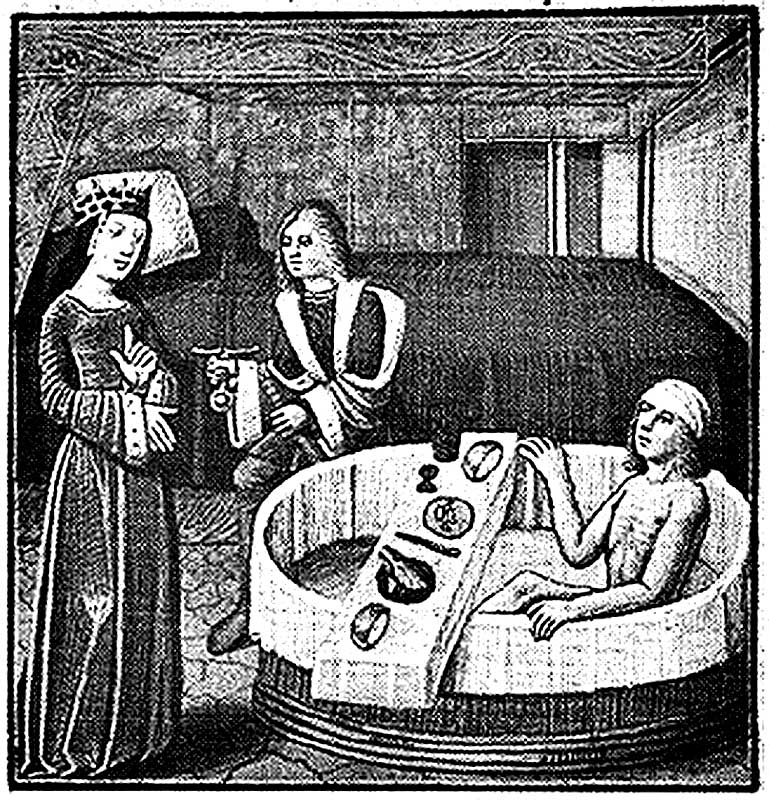DAILY DIRT: A once-a-year bath? Well, at least the man of the house got to go first


I wouldn’t want of that peas porridge, whether it was nine days old or not … Welcome to today’s three thoughts that make up Vol. 915 of The Daily Dirt.
1. One of my most favorite people I have worked with over the years is Jo Lynn Tappe.
On Fridays, Jo Lynn would always bring an assortment of snacks to the office. Neither Jo Lynn or myself ever met a bag of chips or a package of cookies we didn’t like.
It’s been a few years since Jo Lynn and I would spend those Fridays increasing our calorie intake, but I still hear from her on occasion when she emails me with some information she thinks Daily Dirt readers might find entertaining.
Today is one of those days.
Jo Lynn said a friend of hers had uncovered the following about the 1500s:
Most people got married in June because they took their yearly bath in May, and they still smelled pretty good by June. Since they were starting to smell, however, brides carried a bouquet of flowers to hide the body odor. Hence, the custom today of carrying a bouquet when getting married.
Baths consisted of a big tub filled with hot water. The man of the house had the privilege of bathing first in the nice clean water, followed by all of the other sons and men, then the women, and finally the children. Last of all were the babies. By then the water was so dirty you could actually lose someone in it … hence, the saying, “Don’t throw the baby out with the bath water!”
Houses had thatched roofs — thick straw piled high, with no wood underneath. It was the only place for animals to get warm, so all the cats, mice and bugs also lived in the roof. When it rained it became slippery and sometimes the animals would slip and fall off the roof, resulting in the idiom, “It’s raining cats and dogs.”
There was also nothing to stop things from falling into the house. This posed a real problem in the bedroom where bugs and other droppings could mess up a nice clean bed. Therefore, a bed with big posts and a sheet hung over the top afforded some protection. That’s how canopy beds came into existence.
The floor was dirt. Only the wealthy had something other than dirt, leading folks to coin the phrase “dirt poor.”
In those old days, they cooked in the kitchen with a big kettle that always hung over the fire. Every day they lit the fire and added things to the pot. They ate mostly vegetables and did not get much meat. They would eat the stew for dinner, leaving leftovers in the pot to get cold overnight and then start over the next day. Sometimes stew had food in it that had been there for quite a while, and thus the rhyme, “Peas porridge hot, peas porridge cold, peas porridge in the pot nine days old.”
Sometimes the people could obtain pork, which made them feel quite special. When visitors came over, they would hang up their bacon to show off. It was a sign of wealth that a man could, “bring home the bacon.” They would cut off a little to share with guests and would all sit around and “chew the fat.”
Thanks for the info, Jo Lynn. That’s the kind of stuff we don’t read in traditional history books.
2. Here’s a few “rules” of etiquette that have slipped through the cracks over the years:
Your right hand was always your “social” hand, while your left hand was your “personal” hand. You were never supposed to cough into your right hand. (Actually makes sense. Would you want someone coughing into their right hand, then shaking hands with you?)
In the ’50s and ’60s, there were a lot of dos and don’ts for a woman to follow, including how to position her arms. A woman was advised not to let her hands hang straight to her sides, since it would detract from her silhouette.
Well into the 1920s, parenting experts like John Watson told parents to never hug or kiss their child and to leave them in their crib as much as possible if they didn’t want them to be spoiled. This was meant to build strong character in the child, Watson wrote in “Psychological Care of the Infant Child”.
3. There are some foods that are safe, seemingly forever, such as:
Vinegar: It never expires. Never. Over time, vinegar can become hazy or develop sediment, particularly a gelatinous substance called “mother,” though that doesn’t mean you need to toss it — in fact, vinegar mothers (a.k.a. a colony of healthy bacteria that forms in fermented liquids, can even be used to create a new batch of the multipurpose solution).
White rice:At temperatures under 40 degrees Fahrenheit, white rice’s life span pushes upwards of 25 to 30 years. Even when stored at warmer temperatures, it can last up to 10 years if packed with oxygen absorbers. However, not all rice keeps long-term; opened bags should be used within two years, and brown rice lasts about six months at room-temperature storage because of its naturally occurring oils, which can go rancid.
Sugar: Helping sugar maintain a long shelf-life means keeping it away from any source of condensation or moisture. Food storage experts, however, say sugar is “best consumed” within two years of opening.
Salt: Vegetable, animal, or mineral? Salt falls in the latter category, which is one reason it can enjoy an indefinite stay in your pantry without spoiling. Salt has been used to preserve foods (especially meats) for centuries because it’s so effective at inhibiting bacteria. Salt is also able to break down enzymes that help germs grow while also dehydrating food and removing water that bacteria needs to thrive.
Vanilla extract: Real vanilla extract doesn’t spoil thanks to its high alcohol content, but imitation vanilla lasts just six to 12 months before beginning to degrade and losing its flavor.
Honey: Beyond its use in cooking, the substance has also been used for healing wounds and even as a natural preservative — because the insect-produced food is one of the few that rarely expires. Honey’s indefinite shelf-life is thanks to its sugar-dense composition, with less than 20 percent of its makeup coming from water. The nectar also has two other preserving factors: It has an acidic pH level that is unsuitable for bacteria, and its viscous state creates an oxygen barrier that prevents pathogens from growing. However, there is a catch: To maintain these properties, honey must be stored in a sealed container, safe from humid conditions.
Steve Thought O’ The Day — Jack was nimble, Jack was quick. But Jack still couldn’t dodge Chuck Norris’s roundhouse kick.

Steve Eighinger writes daily for Muddy River News. Will he be out of bed before the eclipse today?
Miss Clipping Out Stories to Save for Later?
Click the Purchase Story button below to order a print of this story. We will print it for you on matte photo paper to keep forever.

